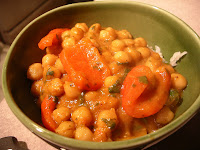Dried Beans
pros: cheaper, more varieties available dried, no metal can = less waste, often have less sodium, no bisphenol-A (used in the lining of many cans and may be harmful to humans), can season while cooking, have a firmer texture, and some say better taste.
cons: take a long time to prepare, you need to soak the beans to rehydrate them (look here for more soaking and cooking info).
Canned Beans
pros: quick and easy.
cons: some chemicals may leech from the can into the beans, sometimes high sodium, may not taste as good.
So maybe dried is the way to go unless you are doing something last minute.
On to the chana! Here is the plan.
2 cups cooked chickpeas
1 tablespoon cumin seeds
1 tablespoon black mustard seed
1 large onion (chopped)
2-4 cloves garlic
1 finger-length piece of ginger
hot peppers (at your discretion)
4 large tomatoes
1 teaspoon cumin powder
1 tablespoon coriander powder
2 teaspoons turmeric
1 tablespoon garam masala
1-2 bell peppers
Fry up the cumin and mustard seeds till they start to pop. Add the onion, garlic, ginger, and hot pepper and cook till the onions seem satisfied. Add the powdered spices and stir up a bit. Toss in the tomatoes and salt. Cook until the tomatoes reduce to a sauce (you can mash 'em up with your cooking spoon to speed things along). Lately I really like throwing things in the blender to make a smooth sauce, so if that floats your boat now would be the time to do it. After blending or not blending you can add the chickpeas and some water if you need to adjust the consistency of the sauce. You can also add some bell peppers at this point and let it simmer. You could also do it with potatoes and you get aloo chole. When we made this last night, I think we got a little carried away with the hot peppers (at least 10 hot thai peppers). I recommend not going this route even if you like spicy, as it was a little in your face. Here is what it looked like when we finished:












